Introduction to the difference between OOP and POP
The basic difference between OOP and POP both are programming methods, with OOP denoting “Object-Oriented Programming” and POP denoting “Procedure Oriented Programming.” OOP and POP both are high-level programming languages that solve problems, but they take distinct techniques. Programming paradigms are the technical terms for these methodologies. Because there is no one-size-fits-all solution to a problem, a programmer might use a variety of approaches while writing software.
This is where the use of oop and pop programming languages comes into play. A programme makes it simple to solve a problem by adopting the correct technique, or paradigm, as the case may be. Two such paradigms are object-oriented programming and procedure-oriented programming. A programming language is a set of rules and procedures that programmers use to give computers instructions to carry out. Every programming language has its own syntax, which allows you to tell a computer what tasks it should accomplish once you’ve learned it.
Computers are extremely powerful devices. With a computer, we can swiftly calculate numbers and create remarkable programmes for a variety of uses. To take advantage of this power, though, we must communicate with the computer in a less uncomfortable manner than manually entering ones and zeros.
As a result, we have programming languages that are supported by previously created machine code. The further we get away from machine code, the more abstract and specialized languages become in data management. This is why there are so many languages: no single language is ideal, and they all serve various and overlapping purposes.
Consider it this way: English is a language that allows you to communicate with other people who speak the same language as you. You can communicate with anyone who understands the basic norms of English if you know them. Computers, on the other hand, cannot understand English or any other “conventional” language.
Object-Oriented Programming (OOP)
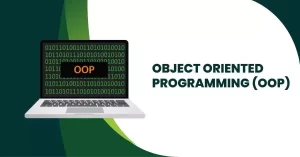
OOP is a high-level programming language that uses the object-oriented concept to break a program into discrete parts called objects, hence the name. Objects and classes are the foundation of this paradigm.
- Object – An object is a self-contained entity that stores data as well as techniques for manipulating it. Objects are nothing more than sub-classes of classes.
- Class – In simple terms, a class is an object’s blueprint that defines all of the common properties of one or more objects that are associated with it. Within a program, a class can be used to define many objects.
- Methods – Methods are functions specified within a class that describe an object’s actions. In class declarations, each method begins with a reference to an instance object. In addition, instance methods refer to the subroutines that make up an object. Methods are used by programmers to ensure reusability and to keep functionality contained to a single object at a time.
- Attributes – The state of an object is represented via attributes, which are defined in the class template. Data will be saved in the attributes field of objects. The class’s attributes are the class’s own.
By splitting a programme into data and functions that are packed within the objects, the OOP paradigm focuses on the data rather than the technique to develop modules. When a new object is introduced, the modules can’t be changed, and non-member functions can’t access the data. The only way to evaluate the data is to use methods.
The same member functions can be used by objects to communicate with one another. Message passing is the term for this technique. The program’s security is based on the objects anonymity. A programmer can construct a new object by combining the features of several existing objects, making the programme simple to implement and modify.
The 4 pillars of OOP can be described below as:
- Abstraction – Abstracting something implies hiding the implementation details within something – often a prototype, sometimes a function. As a result, you do not need to know exactly what the function does when you call it. You would never code anything if you had to know every single function in a large codebase. Reading it all would take months.
You don’t have to be concerned about the operation of the function. It’s taken care of. This greatly facilitates code reuse! It also makes your code much more maintainable. That is the essence of abstraction. Finding similar items in your code and creating a generic method or object that can be used in various places/with multiple concerns.
- Polymorphism – Polymorphism is defined as “the property of appearing in multiple forms.” That’s exactly what the fourth and final pillar is about: different types in the same inheritance chains can accomplish different things.
You can now use parents as if they were their children if you used inheritance correctly. When two types share an inheritance chain, you can use them interchangeably in your code without encountering any errors or assertions. Polymorphism’s true value lies in sharing behaviors and allowing custom overrides.
- Inheritance – Inheritance allows one object to get access to the attributes and methods of another. Prototypal Inheritance is used in JavaScript to do this. The key advantage is reusability. We understand that there are occasions when numerous locations must accomplish the same job, and they must do everything the same except for one minor detail. This is a problem that can be solved using inheritance.
Maintain a straightforward and predictable inheritance. Don’t inherit from a completely unrelated place just because you require a single method or property. Inheritance isn’t very good at solving that problem. You should require the majority of the functionality when employing inheritance (you don’t always need everything).
- Encapsulation – Encapsulation is defined as “the act of enclosing anything in or as if in a capsule.” Encapsulation is all about removing access to bits of your code and making things private (oftentimes, people refer to it as data hiding). Each object in your code should be able to control its own state, which is known as encapsulation.
The current “snapshot” of your item is called state. The keys, your object’s methods, Boolean properties, and so on. All changes to your state are made when you reset a Boolean or delete a key from an object. Limit the parts of your code that can be accessed. If they aren’t needed, make more things inaccessible.
Advantages of Object-Oriented Programming (OOP)
-
Maintenance of the Code – This is more of a must for any programming language; it saves users time and effort in a variety of ways. Maintaining and modifying current codes by adding new changes is always simple and time-saving.
-
Security – We are filtering out restricted data to expose through data hiding and abstraction mechanisms, which means we are keeping security while offering critical data to see.
-
Re-usability – It entails repurposing some facilities rather than constructing them from scratch. This is accomplished through the usage of a class. We can use it an unlimited number of times depending on our needs.
-
Redundancy of data – This is a circumstance that occurs when the identical piece of data is store
d in two different places (you can call it a database). As a result, data redundancy is one of the most significant benefits of OOP. If a user requires similar functionality in several classes, he or she can write common class definitions for those functions and inherit them. -
Benefits of Design – If you practice OOPs, the design benefit a user will receive is in terms of designing and repairing things quickly, as well as eliminating risks (if any). Object-Oriented Programs compel creators to go through a lengthy and thorough design phase, resulting in better designs with fewer faults. It’s easier to program all the non-OOPs independently after the program has hit some crucial constraints.
-
Performance – Object-oriented languages are notoriously slow. OOP programmes are typically larger and need more computational effort to operate than programmes written in functional languages. This isn’t always the case or even relevant. C++ is an object-oriented programming language that is also one of the quickest. On the other hand, speed isn’t always necessary. The speed difference is only noticeable when computing large or complex calculations or when extreme speed is required.
Dis-Advantages of Object-Oriented Programming (OOP)
- Packages and libraries:
Another downside of Object-oriented Programming is that it necessitates the installation of packages and libraries in order for the code to work correctly. These libraries are designed to make the writing process considerably easier for developers, but they may be complicated and difficult to grasp for those who like to type their code out line by line.
- Size:
Object-Oriented Applications are significantly larger than other kinds of programs.
- Effort:
Object-Oriented Programs require a lot of work to create.
- Speed:
Because of their size, Object-Oriented Programs are slower than other applications.
- Difficult to Grasp:
One drawback of Object-oriented programming is the difficulty in comprehending how objects, classes, methods, and actions interact. This may be problematic for folks who are used to programming using a Procedural Programming style.
Development Tools in Object-Oriented Programming (OOP)
When working with Object-Oriented Programming, there are a variety of tools accessible to help the programmer. Many languages include tools designed to assist developers while they code in their native tongue.
JAVA is a fantastic example of an Object-oriented Programming language that makes use of tools to assist the developer. Java includes a wide range of capabilities and software packages to assist in the development process. Eclipse is one of these programs, and it aids in the development of the web and other applications. Android, one of the most popular Procedural Programming platforms, runs Eclipse-based applications.
Eclipse, like many other programmes, offers a user interface that makes it easy to create and test programmes. There is a text editor for direct code editing for developers who are extremely familiar with the language and Object-oriented Programming principles.
There is a GUI interface for less experienced developers that enables for visual editing of apps. This graphical user interface allows the developer to visually drag and drop elements onto the page where the software is located. After the programme has been visually placed, it can be switched to text editor mode to make code changes.
As elements are Procedural Programming onto the page, the GUI interface adds code to the text editor. This makes it much easier for the developer to alter the code because it has already been developed and only requires minimal changes to work properly.
Procedural Oriented Programming(POP)
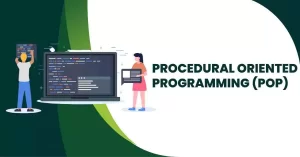
POP is a step-by-step approach to decompose a task into a set of variables and routines (or subroutines) using a set of instructions. Each step is completed in a methodical way so that a computer can understand what has to be done. The programme is broken down into small chunks called functions, which are then followed by a sequence of sequential computational steps.
The name comes from the fact that it takes a top-down approach to solve an issue. Functions correspond to procedures, and each function has a distinct purpose. The cornerstone of procedural programming is to divide the programme into functions. As a result, a variety of functions are written to complete the duties.
Popular frameworks aren’t important while you’re just getting started with programming. However, as you progress up the ladder and begin developing more sophisticated programs and applications, it’s critical to know which programming paradigm is ideal for your project. Before we get started, it’s vital to understand what a paradigm is. A paradigm is defined as “a set of assumptions, concepts, attitudes, and practices that comprise a way of understanding reality for the group that shares them, especially in an academic discipline,” according to numerous referenced definitions.
Initially, all computer programmes are procedural or, to put it another way, in their infancy. As a result, you’ll need to give the computer a set of instructions on how to move from one code to the next and complete the work. Because most functions share global data, they move about the system independently from one function to the next, making the programme vulnerable. Because of these weaknesses, the concept of object-oriented programming was born, which is more secure.
Simply put, procedural programming is laying down a list of instructions that teach the computer how to complete a task step by step.
Advantages of Procedural Oriented Programming(POP)
-
Coding: The ability to jump immediately into coding a program without having to construct any objects or classes is a clear advantage of procedural programming. Many programmers favor this strategy because it allows them to write little bits of code quickly without having to plan ahead of time. Simple forms or HTML pages with basic data could be used as examples.
-
Ability To Grasp: Another benefit of procedural programming is the ease with which it can be learned. Many programmers begin their training by copying code from the internet and pasting it into a running application. There is more to Object-oriented Programming than just copying and pasting code, however, in Procedural Programming, this is a common technique to develop a program.
-
Structure: The top-down structure is also advantageous for those who prefer to work their way through a program rather than planning it out ahead of time. Many creative developers prefer to write their code as if they were reading a tale, discovering and developing as they go.
Dis-Advantages of Procedural Oriented Programming(POP)
A major disadvantage of using Procedural Programming as a method of programming is the inability to reuse code throughout the program. Having to rewrite the same type of code many times throughout a program can add to the development cost and time of a project. Another disadvantage is the difficulty in error-checking.
Procedural programming’s main disadvantage is that it is slower to execute than code written in a lower-level language. This can limit the usefulness of procedural programming in applications that demand a lot of computing power. C and Pascal a
re examples of procedural programming languages.
Following are the major disadvantages of procedural oriented programming:
- Data is exposed to the entire software, hence there is no data security.
- Real-world objects are difficult to relate to.
- Versatility is limited by the difficulty of creating new data kinds.
- The operation on data is given more weight than the data itself.
Development Tools in Procedural Oriented Programming(POP)
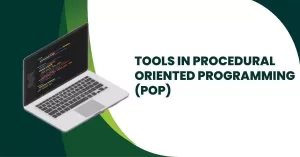
There are many various applications that aid developers who use Procedural Programming as their method of choice, just like there are many different tools that assist developers who use Object-oriented Programming. Procedural Programming, unlike Object-Oriented Programming, may employ a much wider range of programmes to work with. Because most code in Procedural Programming may be written in anything from Microsoft Word to Adobe Dreamweaver, this is the case.
Because of the top-down method utilized in Procedural Programming, most programmes can be developed quickly. Procedural Programming developers prefer to utilize a lot of comments and indentations to visually explain what’s going on in their sometimes lengthy code. With these goals in mind, Procedural Programming applications generally include these features, as well as many others, such as auto-complete for coding to help speed up the process.
For many Procedural Programming developers, Adobe Dreamweaver is the programme of choice. Dreamweaver, like Eclipse, allows you to develop in text or with a graphical user interface. The application’s user-friendliness will vary depending on the programming language used.
Developers who code in HTML may find the GUI to be extremely beneficial, whereas PHP developers may find the GUI to be completely useless.
Adobe Dreamweaver, like many other products, is merely a tool for aiding in the development process. It may be used in both oop and pop, but many procedural programmers prefer it because of its ability to autocomplete and display code in a visually appealing manner.
Object-Oriented Programming (OOP) VS Procedural Oriented Programming(POP)
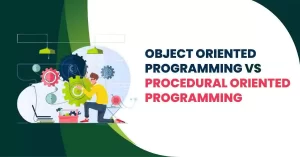
OOP and POP are compared here on various types to help you understand the difference between OOP and POP.
|
Type |
Procedure Oriented Programming |
Object-Oriented Programming |
|
Divided Into |
In POP, the program is divided into small parts called functions. |
In OOP, the program is divided into parts called objects. |
|
Importance |
In POP, functions and the order of operations to be performed take precedence over data. |
Because it works in the actual world, data takes priority over procedures and functions in OOP. |
|
Approach |
POP follows the Top-Down approach. |
OOP follows the Bottom-Up approach. |
|
Access Specifiers |
POP does not have any access specifier. |
OOP has access specifiers named Public, Private, Protected, etc. |
|
Data Moving |
In POP, Data can move freely from function to function in the system. |
In OOP, objects can move and communicate with each other through member functions. |
|
Expansion |
To add new data and functions in POP is not so easy. |
OOP provides an easy way to add new data and functions. |
|
Data Access |
Most functions in POP employ global data for sharing, which can be accessed freely from one function to the next. |
Data in OOP cannot simply flow from one function to function; it can be kept public or private, allowing us to regulate data access. |
|
Data Hiding |
POP does not have any proper way for hiding data so it is less secure. |
OOP provides Data Hiding so provides more security. |
|
Overloading |
In POP, Overloading is not possible. |
In OOP, Overloading is possible in the form of Operator Overloading and Function Overloading. |
|
Examples |
Examples of POP are C, VB, FORTRAN, Pascal. |
Examples of OOP are C++, JAVA, VB.NET, C#.NET. |
Future and Scope of OOP and POP
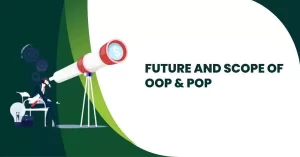
Developers who have been in the profession for even a few years have seen a number of programming languages and tools grow and fall. Because software development is a dynamic sector with continually evolving job requirements, it’s critical to keep an eye on future trends and technologies that could help with the process you need to know about both the oop and pop languages.
According to Panetta, programming will join reading, writing, and arithmetic as a core educational principle for kids. “Data analysis for massive data sets, machine learning, and simulation to lower the cost of testing and manufacturing will be required in every professional career in the future and the concept of oop and pop must be very clear for aspirants.”
Sosulski suggests that anyone interested in becoming a developer begins with an object-oriented programming language such as Python to lay a foundation on which to build.
To prepare for the future, it’s critical for developers entering or working in the sector right now to grasp the architecture behind the tools and frameworks they’re using, according to Hammond of both the oop and oop.
Object-Oriented Programming(OOP)
Many developers just don’t have time to keep up with many languages due to rapid technological advancements and ever-shrinking product cycles. Their decision may influence the types of projects they work on, the companies for which they work, and even whether their talents are regarded as valuable or obsolete. We spoke with Bjarne Stroustrup, the creator of C++, and Tim Lindholm, the distinguished engineer at Sun Microsystems, to help sort out the relevance—both present and future – of the two most popular OOP languages, C++ and Java. Here are their thoughts on programming’s future, rival languages, OOP language progression vs revolution, and programming standards.
With the emergence of structured programming in the 1970s, software developers became the main focus of development. In the 1980s, structured programming grew increasingly polished, and with the advent of object-oriented programming in the 1990s, it became the standard protocol (OOP).
While in the early days of computers, a software engineer was just a technical term for a computer programmer, the position now encompasses much more: interface design, development methods, beta testing, and maintenance, to mention a few. This disparity is one of the reasons why, in today’s market, software engineers may command substantially higher compensation.
Right now, OOP is one of the most popular paradigms. However, this could be owing to the popularity of OOP languages. For Android, Java, C++, and Kotlin rule, while Swift and Objective-C rule for iOS, therefore you can’t write mobile software unless you grasp the object-oriented paradigm. JavaScript, Python, PHP, and Ruby are th
e most popular web programming languages.
Then, in order to appeal to C++ programmers, Java increased the emphasis on the OOP aspect. Sun Microsystems ultimately aimed to recreate the C++ trick by seeking maximum familiarity among Java developers.
Due to its exclusive inclusion in web browsers at the time, millions of developers immediately migrated to Java. When viewed in this light, OOP appears to be a passenger rather than a driver of success.
Procedural Oriented Programming (POP)
The way a procedural language interacts with your devices is crucial. When you utilize a procedural programming language, you give your computer explicit instructions and tell it how to achieve its goals using logic and step-by-step procedures. This is a strategy that looks at jobs from the top down. Data is treated differently in procedural languages than processes, which has an impact on how developers use it. C, Java, and Pascal are examples of procedural programming languages.
However, as your career grows and you get more comfortable in your position, you begin to focus on certain areas within your field. Procedural programming is one of the major stumbling blocks. Many different software codes use procedural programming, yet it may not be the best option for every task.
Procedural programming languages are older and easier to understand than other types of computer languages. As a result, many programmers begin their education by practicing in a procedural environment. When dealing with procedural languages, the basic strategy is to look at the complete programme and then split it down into individual procedures. You then break down those processes into smaller sub-procedures, and so on, until the app is broken down into manageable bits.
You may believe that procedural programming is a thing of the past, no longer in use in the commercial world. That is not the case, however. Many vocations necessitate a solid understanding of procedural programming. Some of those jobs can be rather lucrative, so it’s not always a smart idea to dismiss procedural programming right once.
Procedural programming is an excellent technique to tackle general programming jobs that don’t require a lot of reusable code or real-world objects because it’s easy to grasp and use. Many of the apps you develop, on the other hand, don’t function well with procedural programming, and it’s critical to understand why so you can address each issue properly.
Procedural programming has been around for a long time and shows no signs of going away anytime soon. Our guide walks you through the basics of procedural programming and shows you how it’s used by developers.
Because Java is at least partially a procedural language, you’ll have no trouble landing a top job if you have strong procedural skills. Web developers frequently employ procedural languages in their work, and you’ll be able to locate a variety of server-side applications and back-end platforms that require a motivated coder with procedural programming skills.
Conclusion
On comparing both oop and oop, object-oriented programming makes programming easier. It has a variety of values, including reusability, efficiency, and code maintenance. While understanding OOP’s ideas may be difficult at first, I guarantee you that the payoff will be well worth the effort. I hope this post was able to help you understand those topics more clearly!
Procedural and object-oriented programming paradigms are frequently contrasted. This is due to the fact that both can handle data and modules, such as procedural programming functions and object-oriented methods.
“Though languages, frameworks, and suppliers change over time, these implementation patterns tend to repeat themselves,” Hammond added. “If you grasp it, you’ll be able to notice changes as new technologies emerge and use what you already know in these new situations.”
In procedural programming, data-processing procedures and modules are viewed as independent entities. In OOPs, however, methods that operate on an object’s data are considered the same thing.
The phrase “software engineer” dates back to roughly 1950 when the concept of computing devices became a reality. The position was once thought to be synonymous with that of a computer programmer, and they were more akin to high-level mathematicians than those who handled code. Did they learn how to extract algorithms from calculations and patterns, and how to use these patterns to imitate yes/no choices by a computer through quick iterations?
Now you know what an object-oriented language is, what it can do, and which ones are the most popular. Programming with these languages may be as entertaining as it is profitable, and you’re only a few steps away from a career in development.
Frequently Asked Questions on OOP and POP
1. What is the difference between OOP and POP?
The basic difference between oop and pop is:
OOP
OOP refers to Object-Oriented Programming & it deals with objects and their properties. Major concepts of OOP are −
- Class/objects
- Abstraction
- Encapsulation
- Polymorphism
- Inheritance
POP
POP refers to Procedural Oriented Programming and deals with programs and functions. Programs are divided into functions and data is global.
Following are the important differences between OOP and POP.
|
Sr. No. |
Key |
OOP |
POP |
|
1 |
Definition |
OOP stands for Object-Oriented Programming. |
POP stands for Procedural Oriented Programming. |
|
2 |
Approach |
OOP follows a bottom-up approach. |
POP follows a top-down approach. |
|
3 |
Division |
A program is divided into objects and their interactions. |
A program is divided into functions and they interact. |
|
4 |
Inheritance supported |
Inheritance is supported. |
Inheritance is not supported. |
|
5 |
Access control |
Access control is supported via access modifiers. |
No access modifiers are supported. |
|
6 |
Data Hiding |
Encapsulation is used to hide data. |
No data hiding present. Data is globally accessible. |
|
7 |
Example |
C++, Java |
C, Pascal |
2. Why is it better: POP or OOP?
In the difference between oop and pop, POP stands for Procedure-oriented programming and is a programming strategy that focuses on procedural abstractions rather than data. OOP stands for Object-oriented programming and is a programming method that focuses on data rather than the algorithm.
OOP is more safe than POP because of the data hiding feature, which restricts data access to member functions of the same class, whereas POP has no such feature, making it less secure. Object-oriented systems are easy to edit since new data objects may be easily formed from existing objects, but POP does not provide a straightforward procedure for adding data, at least not without rewriting the entire show. To access properties or functions in OOP, there are three accessing modes: ‘Private,’ ‘Public,’ and ‘Protected.’
Because an object’s data and functions are treated as a single entity in OOP, access is limited to member functions of the same class. Data can travel freely in POP, on the other hand, because each function holds separate data. Object-oriented systems are easy to edit since new data objects may be easily formed from existing objects, but POP does not provide a straightforward procedure for adding data, at least not without rewriting the entire program. This is a difference between oop and pop.
3. What are the 4 basics of Object Oriented Programming?
This programming approach may be found in several prominent programming languages, including Java, C++, Python, JavaScript, and C#. Classes can be arranged into modules by defining sets of classes that represent and encapsulate objects in a programme. This improves the structure and organization of software applications. As a result, developers frequently use OOP as a tool when creating large programmes since classes and their relationships are easier to reason about. This is an important difference between oop and pop.
Encapsulation, abstraction, inheritance, and polymorphism are the four essential concepts of object-oriented programming. Even if these notions appear to be quite complicated, understanding the broad structure in which they operate can aid you in comprehending the fundamentals of an OOP computer programme. We’ll go through these four fundamental principles and what they encompass in more detail below and difference between oop and pop:
- Encapsulation
- Abstraction
- Inheritance
- Polymorphism
To know more about the same you can simply click here.
4. What is the full form of POP & OOP?
Here in the difference between oop and pop is mentioned below:
Object-Oriented Programming (OOP) is a type of high-level programming language that divides a programme into objects. The programmer can create realistic settings by using objects. An object is a class instance with state and behavior. The attributes, or data, are the state, whereas the behavior is referred to as a method.
Procedural Oriented Programming is a programming style that focuses on the functions or procedures needed for computation rather than the data itself. The programme is broken down into functions, and each task is completed in order. The global data or variables are shared by these functions, and data is exchanged between them a difference between oop and pop.
5. What is meant by encapsulation in Object Oriented Programming?
The concept of encapsulation (or OOP Encapsulation) in object-oriented computer programming (OOP) languages refers to the bundling of data and the functions that operate on that data into a single unit difference between oop and pop.
Encapsulation is commonly used in the form of classes in several programming languages. A class is a type of program-code template that allows programmers to design objects with both variables (data) and behaviors (functions or methods). In computer science, a class is an example of encapsulation since it consists of data and procedures that have been bundled into a single unit.
Encapsulation can also refer to a mechanism that prevents users from directly accessing specific components of an object, such as state values for all of the object’s variables. Data members as well as data functions or methods linked with an instantiated class or object can be hidden via encapsulation this is difference between oop and pop.
6. What is polymorphism in Object Oriented Programming?
In the difference between oop and pop, Polymorphism is a basic notion in object-oriented programming (OOP) that describes instances when something appears in several forms. It is a concept in computer science that you can access objects of various types through the same interface. This interface can be implemented in a variety of ways by each type.
A simple test can be used to determine whether or not an object is polymorphic. The object is polymorphic if it successfully passes several is-a or instanceof checks. All Java classes extend the class Object, as explained in our previous lesson on inheritance. As a result, all Java objects are polymorphic, as they pass at least two instanceof checks.
In the difference between oop and pop, Object-oriented programming (OOP) is a programming paradigm based on the concept of “objects,” which can hold data and code in the form of fields (also known as attributes or properties) and procedures (often known as methods).
The ability of an object’s own procedures to access and often modify the data fields of the object is one of its features (objects have a notion of this or self). OOP is a programming language that allows you to create computer programmes out of objects that interact with one another. The most popular OOP languages are class-based, which means that objects are instances of classes, which also determine their types.
Many of the most popular programming languages (such as C++, Java, Python, and others) are multi-paradigm and enable object-oriented programming to some extent, usually in conjunction with imperative, procedural programming. Java, C++, C#, Python, R, PHP, Visual Basic.NET, JavaScript, Ruby, Perl, SIMSCRIPT, Object Pascal, Objective-C, Dart, Swift, Scala, Kotlin, Common Lisp, MATLAB, and Smalltalk are all important object-oriented languages. This is a difference between oop and pop.

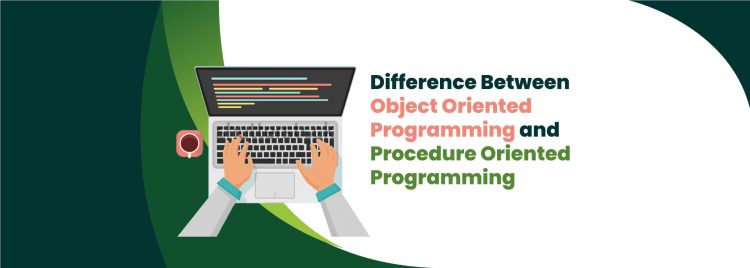












One response to “Difference Between OOP and POP | DataTrained”
[…] gets confused between OOPs and POPs, so here we have listed difference between OOPs and POPs. POP is a step-by-step approach to decompose a task into a set of variables and routines (or […]